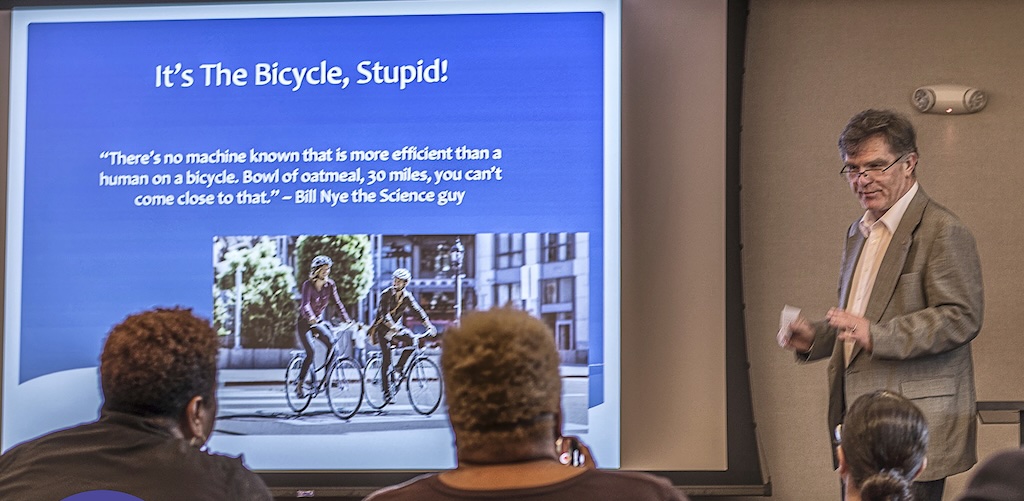Autumn Gear Guide
Find inspiration in our Gear Guide that will keep you out on your bike through wind or rain.
Download NowThis year, I was delighted to celebrate the 7th Annual World Bicycle Day at the World Bank in Washington, DC. Inspired and organized by staffers who are avid cycling enthusiasts they also seek to adopt bicycle use as part of their professional mission. The event was actively attended by high-management representatives from the transport and […]
This year, I was delighted to celebrate the 7th Annual World Bicycle Day at the World Bank in Washington, DC. Inspired and organized by staffers who are avid cycling enthusiasts they also seek to adopt bicycle use as part of their professional mission. The event was actively attended by high-management representatives from the transport and infrastructure sector, who also indicated their support for active mobility.
Coincidentally, this very institution was the birthplace of World Bicycle Day. In 2014, while serving as a consultant for a World Bank climate change trust fund, I pondered the question: Why doesn’t the UN have a dedicated day for bicycles? This curiosity sparked a blog post in February 2015 titled “Cycling is Everyone’s Business,” which surprisingly became the most popular World Bank blog that year, and was reprinted by the World Economic Forum and even the Vatican. In between, I also created an advocacy project for my sociology students that proved to be a valuable teaching moment for many. Since then, I have never looked back, and on April 12, 2018, I witnessed a vote by all member states of the UN General Assembly unanimously adopting a resolution to declare June 3rd as World Bicycle Day. Until then, the bicycle, one of mankind’s most reliable and loyal inventions had no specially recognized mention and vision for its role today and for the future.
The bicycle is unique and deserves attention as an asset for both global and local communities. Politicians also probably underestimate the power of cyclists who vote to take their freedom to pedal safely very seriously. As citizens, cyclists tend to be organized and active, commanding a bulk voting power that advocates for global policy change.

Leszek Sibilski and friends with a World Bicycle Day proclamation
Many of us underestimate the bicycle’s uniqueness, longevity, and versatility. This simple two-wheeled device has provided economically reliable transport to humanity for over two centuries. There is also something very unique about bikes. The synergy between the bike and the user fosters activity and social engagement and gives the rider immediate awareness of the local environment. As a tool for green development, a bicycle can mean not just transportation but employment and even access to education and health care.
Have you ever wondered what happened to once commonplace items such as the abacus, the slide rule, the hourglass, or the quill, not to mention VHS recorders, CD cassette players, and more recently, address and telephone books? They all met the same fate: they were replaced by modern technological innovations such as calculators, electronic watches, ballpoint pens, and computers. And what happened to the bicycle? It has been with us for over 200 years. The bike is a veteran and mainstay of human mobility. Over half of the human population can ride a bike. Therefore, the primary goal of World Bicycle Day is to achieve global cycling literacy.
The Day Without a Car or Car Free Day has a negative connotation and does not always meet its expectations. Indeed, World Bicycle Day brings a constructive psychological boost of positivity for everyone involved in active mobility. The humble bicycle has played second fiddle to the car for far too long: not only does cycling cut transport emissions of carbon dioxide, but it also reduces the need for expensive roads and highways.
As we move into the future, let’s commit to preserving the unique contribution of the bicycle and focus solely on it every June 3rd without sharing the spotlight with other modes or types of transportation. We know from history that bicycles suffered a great deal three times because society, including the bicycle industry, lost sight of the practicality and virtues of cycling. We must trust in the wisdom of the global cycling community that these episodes of history will not repeat themselves and that the sovereignty of the bicycle will be protected for upcoming generations. Let’s commit to being vigilant by placing appropriate safeguards if needed to make that happen.
Integrating cycling into mainstream public transportation systems in the planning and implementation process for decarbonization assures us of the bicycle’s health benefits, environmental gains, and communal dividends for generations to come. After all, cycling is everyone’s business—not just cyclists! Cycling is recognized for its role in mass transportation and must be treated as integral.

Leszek Sibilski
Cycling as an integrated public transport means giving a fresh perspective on local travel. For decades, people have either walked, cycled, driven, or taken a bus, train, or tram to their destination. However, this view overlooks multi-modal trips, in which people can use bicycles to access a train station or their final destination from a train station. Cycling and mass transit can be and have become powerful complements in many cities.
Cycling is limited in its practical range but is highly flexible in terms of destination and trip timing. Public transport (particularly rail) can cover greater distances with high capacity, but because it runs on routes with timetables, public transport needs more flexibility in destinations and trip timing. From an individual traveler’s perspective and the transport system overall, substantial gains can be made by combining the strengths of each mode of transport. Cycling allows commuters, travelers, and tourists to access more distant public transport stops and stations than walking.
A surface-level benefit of multi-modal traveling is its time-saving potential. However, the real power of multi-modal travel is its variety. While using cycling rather than walking, commuters can access a broader range of stations for any given travel time. In addition, travelers can optimize their journey to better suit their needs. This could include cycling to a station with direct services to the destination rather than requiring a transfer or allowing travel through a scenic neighborhood with cafes, grocery stores, dog parks, playgrounds, and, maybe, a few old friends along the route. Integrating cycling with public transport allows for a more livable community and more choices for commuters who access train stations or bus stops.
The bicycle was invented in 1817. Have you ever wondered why the bicycle was invented so late in time? After all, all the ingredients were in place much earlier. The first metal was smelted around 5,000 BC, and the wheel was invented around 4,000 BC. The very first bicycle, also known as a “running machine,” was within the capabilities of an average medieval carriage maker.
Yet nobody cared to combine the various elements until an enterprising German baron named Karl von Drais made the first significant development in 1817, creating a lightweight, steerable, two-wheeled contraption called a “running machine.” In contrast, the train (steam locomotive) was invented in 1804.
Undoubtedly, roads prior to the 1800s were often dirt, rutted from the passage of many carts, and turning muddy in the rain. Macadam paving, which gave roads smooth surfaces, wasn’t invented until about 1820. City roads at the time were paved with cobblestones, suitable for horses but too bumpy for bicycles. The widespread advertising, production, and use of these devices stimulated the grading of smooth roads in the late 19th century. Interestingly, Carlton Reid, in “Roads Were Not Built for Cars,” explains that infrastructure for bicycles, tricycles, and other types of velocipedes were precursors to the later transportation system dominated by automobiles.

Leszek Sibilski
But what exactly inspired Drais? In 1815, Mount Tambora in Indonesia erupted in the most powerful volcanic eruption in recorded history, causing a volcanic winter. The following year, 1816, became known as the year without a summer. Crops failed, the Thames River froze, it snowed in July, food became unaffordable, starvation set in, and many horses—the primary mode of transport in Europe—died.
Karl von Drais was prompted to develop an early bicycle in Germany to replace all those dead horses. That is the origin story of the bicycle—this wonderful contraption most of us use daily.
Today, cycling is often the fastest, most flexible, and most reliable way to get around cities and to commute between rural villages and towns. It moves not only people but also goods.
Due to the climate crisis, rising transport emissions, and our modern, sedentary lives, the bicycle is now more than just a remarkably efficient mode of transport—it‘s also a hugely important mechanism for improving human and planetary health.
The impact of the triple planetary climate crisis, environmental loss, and pollution creates fertile ground for the continued comprehensive development of bicycle transport worldwide. It isn’t just a bicycle renaissance or revolution; it is a shift of gears to move us most efficiently in the right direction at an accelerated speed!
I firmly believe that the World Bank’s mission, “To create a world free of poverty—on a livable planet,” can be achieved with greater practical efficiency by including and expanding bicycle use as a tool for transport and trade. Their development and history prove it.
Lastly, as a former member of the World Bank community, I encourage the institution to do more to convey the loud and clear message that the World Bank is open for business and ready to receive more government requests to improve cycling infrastructure worldwide, especially in the Global South. Let’s hope that the World Bank’s commemoration of World Bicycle Day next year will be associated with additional tangible results, leading us to celebrate, but most importantly, to employ the bicycle every day on all inhabited continents.
Find inspiration in our Gear Guide that will keep you out on your bike through wind or rain.
Download Now
Leave a comment